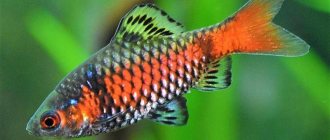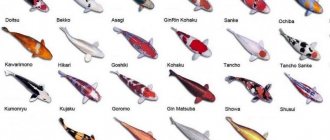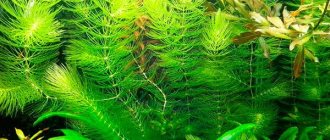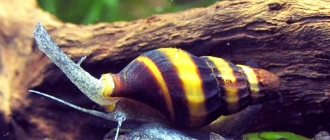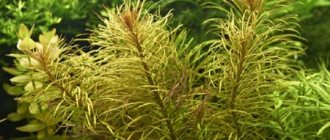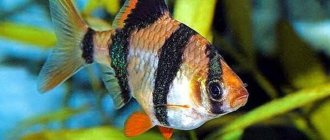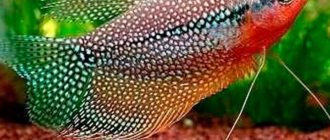There is a lot of information about the barb on the Internet. On many sites, fiery barb, golden barb, green barb and Schubert barb are mixed together. And today we intend to give explanations so that everything falls into place.
Fire barb
On a note ! The fire barb is an independent species . This is the first barb to be bred in an aquarium. Its color is similar to goldfish, but much more active. An excellent option for those who like to watch the bright, moving inhabitants of the aquarium!
Appearance of the fiery barb
The body of the fish is oval, flattened laterally and elongated in length - in a word, it is maximally adapted to rapid swimming. antennae , the head is pointed. In aquarium conditions, it often does not grow more than 7 cm, but in the wild there are individuals up to 10-15 cm.
Fire barb. Appearance
The color varies from pale pink to bright orange (it all depends on the specific variety). In males, the back has a greenish tint. Red fins often have a black border. A forked caudal fin with a dark spot at the base. There is also a veil form with highly developed fins.
Fire barb. Veil form
Life expectancy in aquarium conditions is about 5 years .
Interesting Facts
- It is interesting to watch a school of these fish because they are constantly on the move.
- This is just one of several species based on the Rosy Barb. Others include fish such as Long Fin Rosy Barb, Red Glass Rosy Barb and Gold Neon Rosy Barb.
- Males will spend most of their time swimming around each other, displaying themselves by spreading their fins and displaying their best colors.
- The species was first introduced to Europe at the beginning of the 20th century.
- The number of fry can reach up to 500 individuals.
- When these individuals mate with black and scarlet barbs, infertile cubs will be born.
Habitat
The fiery barb has a fairly large habitat - the northeast and east of India. In addition, the fish is found in Afghanistan, Nepal, Bangladesh, and Pakistan. The barb has taken root well in some other countries where it was introduced artificially (Colombia, Mexico, Australia, etc.).
Stamp with the image of a fiery barb. Vietnam, 1987
On a note ! Depending on the geographic region, habitat conditions can vary greatly. The fish is found both in tributaries of rivers and fast streams, and in slowly flowing or even almost stagnant bodies of water.
Video – Fire Barb
Feeding
The fire barb is an omnivorous fish; in its natural environment it eats small invertebrates, their larvae, worms, and algae. In captivity, they can be fed with dry food, live food (bloodworms, coretra, brine shrimp, tubifex), and plant foods, for example, algae, lettuce, spinach.
We talked about the contents of the fiery barb above. Now let's look at the issue of feeding. What do aquarium robbers eat? Dry food is the basis of nutrition. These can be universal flakes or small granules.
But dry food is not a panacea. To keep them active and healthy, these fish are fed frozen food in addition to dry food. It can be bloodworms, tubifex, daphnia, coretra. Only freezing must be of high quality. Before giving it to the fish, a small piece is cut off from the general briquette and, without defrosting, is given to the inhabitants of the aquarium.
- bloodworm;
- tubifex;
- daphnia;
- gammarus;
- Artemia;
- dry food;
- cucumbers;
- pumpkin;
- zucchini;
- lettuce leaves.
Compatibility with other types
The fire barb is a peace-loving fish, but very active. It is important to remember: in a community aquarium they must be kept in a school, and the barbs will not pay attention to other species. Fish with a similar temperament are best suited as neighbors: other species of barbs, mollies, rainbows, dwarf cichlids. The fish are calm about the catfish Ancistrus, Corydoras, and Torakatum.
Schubert Barbus
Dwarf cichlid
Mollies
Rainbow
It is not recommended to keep fire barbs with fish that have long fins; barbs can bite them. Therefore, it is better not to keep them in the same aquarium together with gouramis, laliuses, cockerels, and goldfish.
Note ! Large predatory cichlids (acaras, astronotuses) pose a danger to barbs, so it is also impossible to combine such fish.
Astronotuses
Maintenance and care
The fire barb is an active, hardy fish with low requirements for living conditions. It is often recommended to beginners, including as a bright living decoration for an aquarium. Externally, this type of barb resembles a goldfish. However, unlike the latter, it behaves more actively in the aquarium. This must be taken into account when choosing potential neighbors for Barbus conchonius.
In nature, the fire barb prefers a gregarious lifestyle. For this reason, the aquarist needs to place a group of 8-10 fish in the aquarium at once. Otherwise, even such a peaceful aquatic organism begins to show aggression.
To keep a group of fire barbs you will need an aquarium with a capacity of 80-100 liters. The container must have a lid. Due to its activity, the fish may jump out of the container.
When decorating an aquarium, it is recommended to use natural landscaping. It wouldn’t hurt to add stones and driftwood. However, you should not take up too much space with the design composition - Barbus conchonius should be left with space for free swimming.
Water parameters for ideal maintenance
One of the features of the fire barb is its low water temperature requirements. An aquarium with these aquatic organisms does not require a thermostat, since the fish prefer to be in cool liquid. Experienced owners note that in summer, on the contrary, they have to solve the issue of water cooling.
To make the fish feel comfortable, it is recommended to maintain the following parameters of the aquarium fluid:
- temperature - 16-26ºС;
- hardness - 8-18º;
- acid-base balance - 6.5-7.5.
Every week it is necessary to change a third of the total volume of water. Barbus conchonius is sensitive to pollution and oxygen levels. For this reason, you will need to install a powerful filter and aerator.
Requirements for lighting and landscaping
Barbus conchonius requires diffused light of low to moderate brightness.
Experienced fish owners recommend shading the back wall of the vessel when decorating an aquarium. In this case, the barb will look very advantageous and shimmer with fiery flashes of scales.
This requirement imposes a certain limitation on the choice of aquarium plants that are vital for the barb. They will create hiding places for fish. Additionally, it is worth placing floating plants on the surface of the water to create a diffused light flux. For these purposes, for example, riccia or pistia are suitable.
What to feed a fire barb
The fire barb must be fed both protein and plant foods. The main rule is that food should be balanced, nutritious and varied. If the diet of Barbus conchonius does not have enough plant components, it begins to eat aquarium plants.
It is advisable to alternate feeding dry and live food as often as possible, avoiding monotony.
Invertebrates that form the basis of the diet of these fish in nature can be used as live food for the fire barb:
- worms;
- shellfish;
- insect larvae.
When choosing specialized dry food, you should pay attention to such products as:
TetraPro Color food in the form of chips, which helps maintain the bright colors of aquarium pets;
TetraMin universal food with vitamins, minerals and prebiotics;
Tetra Phyll plant food;
TetraPro Algae is another product enriched with herbal ingredients;
Tetra FreshDelica special treats for fish based on bloodworms, daphnia or brine shrimp;
Sera Viformo fish food with herbal ingredients for various types of fish, including barbs.
Experts recommend feeding your fire barb several times a day in small portions that can be consumed in a few minutes. These fish are prone to overeating. It is advisable to limit them in food once a week to maintain healthy digestion.
Reproduction and breeding
The process of breeding barbs is quite simple. First of all, it is necessary to select the brightest and healthiest breeders. Unfortunately, this is difficult to do before the fish reach sexual maturity, which occurs at the age of 6-8 months. By this time, barbs usually grow up to 6 cm in length. Males of this species are smaller in size, slimmer and have a more saturated color. The female's abdomen is fuller and rounder.
The pair needs to be separated for several weeks, introducing more high-protein feed into the diet.
Female and male fire barb
At this time, a spawning aquarium with a volume of about 10 liters with a water level of up to 15 cm is prepared. A separator net is installed on the bottom, because the fish do not show any concern for the offspring and will eat the eggs at any opportunity.
When the female is ready, she and two males are placed in the spawning area in the morning. Mating dances are not distinguished by sophistication; the male swims next to the female, spreading his fins, attracting her attention. The female's fertility produces about 200-600 eggs. After spawning is completed, the spawners are removed from the aquarium.
Next, you should carefully change 1/3 of the water in the aquarium, shade it and add a couple of drops of methylene blue so that the eggs are not damaged by the fungus. The larvae hatch from the eggs after 1-2 days, and after another day they are capable of feeding on their own.
Diseases and prevention
The most common ailments and methods of getting rid of them are presented in the table.
| Disease | Causes | Signs | Treatment |
| Ammonia poisoning | Overpopulation, rare water changes. | Redness of the gills, tachypnea, living in the upper layers. | Place several fish in a new aquarium, replace the water, and improve aeration. |
| Camallanid infestation | Feed contaminated with nematode parasites. | The fish loses weight, kyphotic curvature of the spine occurs, and rectal prolapse may occur. | Add Piperazine, Fenbendazole mixed with food. |
| Abdominal dropsy | Bacterial infection. | Abdominal enlargement. | Change the water daily and add antibiotics. |
| Ichthyophthiriasis (semolina) | Ciliates. | White rash on body and fins. | Raise the water temperature and enhance aeration. |
| Fin rot | Fungal infection. | Loss of appetite, lethargy, degenerative changes in fins, mossy coating. | Make baths with added salt. |
| Anoxia - oxygen starvation | Overpopulation, low oxygen content, increased water temperature. | The first sign is that the pets constantly stay near the surface and make smacking sounds. With prolonged asphyxia, the fish loses the ability to reproduce and may die. | They find the cause of the lack of oxygen in the water and eliminate it: by changing the aerator, monitoring temperature fluctuations, starting a new aquarium for pets that are too large, and eliminating overcrowding. |
